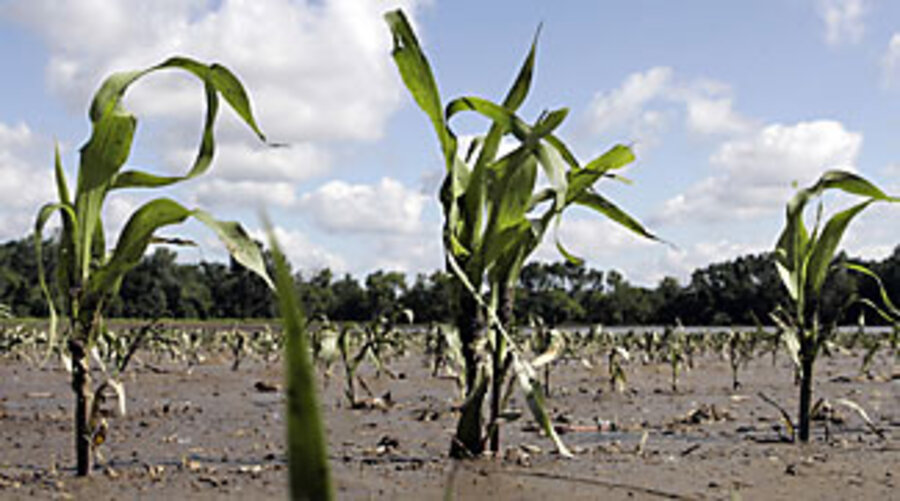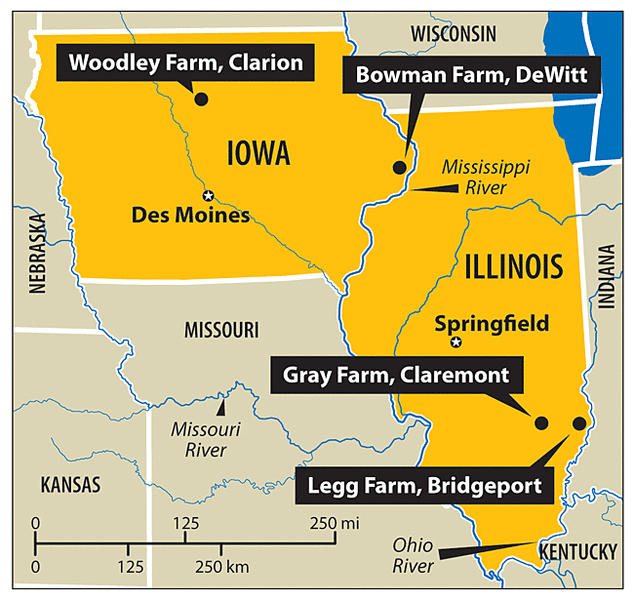Can farmers salvage a soaked planting season?
| Chicago
When the rains finally stopped and the sun began to dry their rain-soaked fields, the Bowman family and their neighbors wasted little time. Last week, they scrambled to plant fields that had lain too wet to plant all spring. Some of them worked late into the night, their high-intensity tractor lights piercing the darkness and global-positioning devices guiding them straight across barren fields.
"A lot of progress has been made this week," says Chris Bowman, who, with his father, farms about 2,000 acres near DeWitt, Iowa. "I'd say a lot of the crop is in."
Receding water and clear weather have rekindled the hopes of many Midwestern farmers. Even as rising water broke through levees on the Mississippi River, flooding more towns and farmland, elsewhere in the region farmers rushed to take advantage of a spell of good weather, eager to salvage what was left of the rapidly concluding planting season.
Some farmers, like the Bowmans, were able for the first time this season to plant fields that had until now been too wet to plant. Others replanted fields for the second or third time. Still others waited anxiously for a few more days of good weather to dry the mud and ponded water that still kept them out of their fields.
At the same time, the improving conditions quickly affected the commodity markets. The price of a bushel of corn, which had risen for two straight weeks, began to fall after reaching record levels of nearly $8 a bushel. Terry Roggensack, an agricultural specialist for The Hightower Report, a firm that does research for brokerage firms and the Chicago Board of Trade, says news of flooding along the Mississippi River was less important than the return of good weather.
"It's very good television and good drama, and it's good to put the guy on there who lost 10,000 acres when the levee broke," says Mr. Roggensack. "But in terms of the grain market, it's a small thing when it's 80 degrees and sunny in the Midwest."
No one knows yet just how much this year's flooding has damaged crops. Flood and rain damage are not the only problems. The cool, wet spring has held back crops almost everywhere. Corn that should rise above the knees at this time of year now barely scrapes the ankles in many places.
Equally uncertain is how, in the end, the weather and flooding will affect prices on the Chicago Board of Trade and in the supermarket. Many people are looking forward to the US Department of Agriculture's crop report that comes out a week from today. Clearly some corn and soybeans, the main crops across Iowa, Illinois, Indiana, and adjoining states, were lost. Researchers at Ball State University in Muncie, Ind., and the University of Tennessee in Knoxville have estimated agricultural damage in Iowa, the largest corn-producing state and the worst hit by the floods, at $2.7 billion.
Farming difficulties vary by region
The challenge for farmers varies widely across the region. Like many farmers, Chris Bowman and his father, Robert, had never managed to finish their spring planting because frequent heavy rains kept the soil too wet to plant. Last week they hired neighbors to help them and, in two days, working day and night with four planters, planted nearly a square mile of soybeans.
"We can't risk getting rained on again," says Robert Bowman, a former president of the Iowa Corn Growers Association. "People are pulling out all the stops."
Jim Legg of Bridgeport, in southern Illinois, faces a far more difficult situation. He had just finished planting earlier this month when the Embarrass River overflowed and inundated every one of his 750 acres. The low ground behind his house lay under 10 to 12 feet of water. He had seen floods before, but never so extensive. The river returned to its banks on Wednesday, and Mr. Legg planted 100 acres of soybeans on the higher ground on Friday. If there was any consolation in his misfortune, it was that the flooding came early enough for him to replant.
"You have to be optimistic, or you wouldn't farm," he says.
Much of the damage across the region was inflicted less by flooding than simply by heavy and frequent rains. Ron Gray, a farmer in Claremont, Ill., was able to plant only about half his 1,500 acres before rain forced him from his fields this spring. He says he will take insurance losses on what he couldn't plant.
"It's a business decision," he says. Planting now might be possible, but the risk of a poor crop is rising with each passing day.
"Good luck has not followed me to here, and to assume I'm going to be lucky from here on is not a good bet," he says.
For Mr. Gray, as for other farmers, the prospect of a poor crop is especially bitter this year because record commodity prices had raised hopes of a highly profitable season. "At this point, the year we could have hoped for is gone," he says.
Farmers across central Iowa, where shallow depressions known as prairie potholes are scattered across the landscape, suffered some of the most widespread damage in the region. Gary Woodley, who farms near the town of Clarion, struggled to plant almost all his crop of corn and soybeans. Then the rains destroyed a fifth of his crop. Water filled the depressions, eroded hillsides, and buried parts of his fields in silt. At the end of last week Mr. Woodley said he was still hoping to replant.
Farmers race against the clock
But time is running out. In a normal year farmers hope to have their corn and soybeans planted by the middle of May so that the crops can mature before the frost. Corn specialist Roger Elmore of Iowa State University in Ames says he spent part of last week running computer programs to figure out whether there was still time to plant corn.
Many farmers say it is already too late to plant corn; most are putting in soybeans, which they can plant until the beginning of June and which are also at record prices.
Even as hopes rise, profound uncertainties remain. If the weather is good this summer, with rain and heat in moderation and at the right times, many farmers say they can still expect a good harvest. But more rain in the next few days, a dry spell at the wrong time, or an early frost could cut their yields dramatically.
The same uncertainty hangs over the commodities markets. Even before the flooding, the Agriculture Department was forecasting tight supplies of corn this fall. Analysts will be looking closely at the long-range weather forecasts released Monday.
"Given we're looking at late-planted crops, it raises concerns for the harvest," says Chad Hart, an agricultural economist at Iowa State University. "How will the weather cooperate? Will we get a hard frost before we're able to harvest the crop in the fall?"
In DeWitt, Iowa, the Bowmans, like many other farmers, are hopeful.
"There's still a lot of potential out here," Chris Bowman says. "It's been pretty challenging for everybody. It was pretty amazing, though, when the weather was good, how fast the crop went in."







